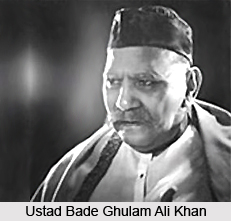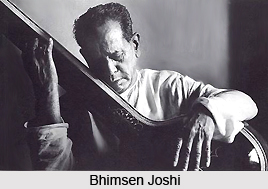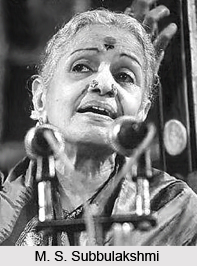Indian Classical Vocalists in Modern Age represent the rich cultural heritage of India of which classical singing is an integral part. Classical music is prevalent in India since ages. This art is not only considered as a mode of entertainment but also as a way of connecting with the divine being. There are various forms of melodies which are collectively known as `Raaga`. Some of them are considered to have divinity which spreads through its rendition. Practicing Ragas is also a way of meditating and a means of connecting with God.
 Ustad Bade Gulam Ali Khan
Ustad Bade Gulam Ali Khan
Ustad Bade Ghulam Ali Khan is also known as the Tansen of 20th century. He has created his unique style of singing by blending different styles of classical music. He has contributed greatly in the Indian classical music and had mastered the flow of words with the tune excellently to confer the real essence of the song. Career of this maestro however spanned a relatively short time. Born in the year 1902, Bade Ghulam Ali Khan belonged to a musical lineage in Western Punjab. He created the best combinations of four music traditions namely, Patiala, Dhrupad, Jaipur and Gwalior. This great musician tried to replace the age old traditional style of Thumri with variations and lesser restraints. This new style of Thumri is now a well established form in classical singing. On 25th April, 1968 this great Indian Classical Vocalist left for heavenly abode leaving behind his magnificent creations for the world to cherish forever.
Dr. Balamuralikrishna
Another legendary name among the Indian Classical Vocalists of Modern Age is Dr. Balamuralikrishna. He was a well admired poet, composer, instrumentalist and singer of Classical Carnatic Music. Dr. Balamuralikrishna had been performing and being admired since the small age of five. He was a renowned child prodigy who had supreme dexterity in tunes and songs of classical music. Born on 6th October, 1930 this singer was immensely famed in the world of Carnatic Music and had contributed a lot in the same. He has also created many new Raagas namely Sumukham, Mahati, Omkari, Trisakthi, Sarvashri, Rohini, Vallabhi, Janasamodini, Manorama, Sushama, Lavangi and Pratimadhyamavathi. In Switzerland, "Academy of Performing Arts and Research" was established by him. He has also contributed a lot in music therapy.
 Pandit Bhimsen Joshi
Pandit Bhimsen Joshi
Pandit Bhimsen Joshi is another highly acclaimed name in the classical music of India. He is a living legend having a sea of fans and appreciations from critics. Bhimsen Joshi is a renowned name in unique Khayal interpretations and Bhajans in Hindi and Marathi languages. Bhimsen Joshi has been honoured with Padma Shri in 1972, the Sangeet Natak Akademi Award in 1976 and the Padma Bhushan in 1985. He had delivered some of his best performances at Sawai Gandharva Sangeet Mahotsav, in Pune.
 M. S. Subbulakshmi
M. S. Subbulakshmi
M. S. Subbulakshmi is greatly famed in the world of Carnatic music. Her enchanting voice confers divinity. She was honoured with the Bharat Ratna which is the highest award presented to any civilian. M. S. Subbulakshmi was born to a musical family on 16th September, 1916, in Madurai, Tamil Nadu. This legendary singer has contributed to the world of classical music since a very small age. She was a flawless singer who devoted herself to Indian classical music and provided the country with some of the most admired compositions. The song Vaishnava Janato is one of her renowned compositions that touch the heart of every listener.
Sulochana Brahaspati
Sulochana Brahaspati is another eminent classical vocalist of India. She was awarded with Sangeet Natak Akademi Award in 1994. Being a student of Pandit Bholanath Bhat and Ustad Mushtaq Hussain Khan, Sulochana Brahaspati became an accomplished teacher and had also published the book Raga Rahasya.
Ustad Nasir Aminuddin Dagar
The noted Indian classical vocalists also enlist the name of Ustad Nasir Aminuddin Dagar who was a famous Dhrupad singer. He had earned the credit of reviving the dhrupad tradition of India. Ustad Nasir Aminuddin Dagar has been honoured with many prestigious awards like Padma Bhushan, Sangeet Natak Akademi Award and Swami Haridas Award. This acclaimed singer established a Dhrupad Institute, naming it after his brother Ustad Nasir Moinuddin Dagar Dhrupad Sangeet Ashram. He has also trained many Dhrupad singers who later emerged as prominent singers of India.
Ustad Inayat Hussain Khan
Ustad Inayat Hussain Khan is a well known Khayal singer and Veena player. He was a resident of Rampur and was the founder of Rampur-Sahaswan gharana. His traditional Khayals and pleasant Taranas were greatly admired. He had received his training from Ustad Bahadur Hussain Khan who was a descendent of Tansen.
Rasoolan Bai
Rasoolan Bai was another legendary Hindustani Classical Vocalist. She was honoured with Sangeet Natak Akademi Award in the year 1957. Born in Uttar Pradesh, in 1902, Rasoolan Bai belonged to a poor family who inherited the musical legacy from her mother and soon mastered the traditional singing of various Raagas. Rasoolan Bai was also renowned for her excellent Tappa singing. This legendary soul left the earth in the year 1974.
Other Notable Indian Classical Vocalists in Modern Age include Hirabai Barodekar, Gangubai Hangal, Hemant Pendse, Devashish Dey, Pt. Mallikarjun Mansur and many more respected personalities who have substantial contribution in the world of Indian Classical Music. These eminent vocalists have not only been honoured in India but have also earned great fame and respect in the whole world owing to their supreme talent.




















